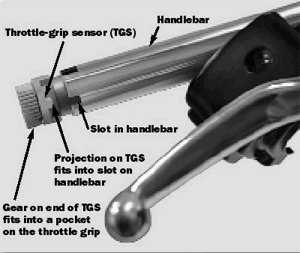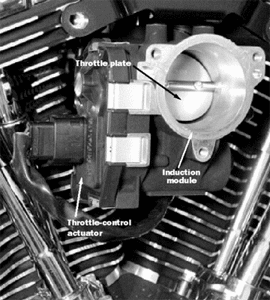Where's a Throttle Body Sensor on a 2004 Goldwing 1800
In 2008 Harley-Davidson introduced a new throttle system called Electronic Throttle Control (ETC), which eliminates the throttle cables connecting the throttle and the throttle body and replaces them with an electronic connection. ETC is standard on all 2008 and 2009 touring models, including CVO touring models.
Four years ago a group of engineers set out to clean up the appearance of the big bikes' handlebars. One item that really caught their eye was the throttle and return cable. Modifying or replacing them would go a long way toward making the bars less cluttered. The engineers also wanted to increase reliability and preciseness in the new system. The path they chose was built on relationships they have with both Delphi Corporation and Magneti Marelli.
When the project began, Magneti Marelli already had over one million electronic throttles on the road, mostly in over-the-road trucks operating in Europe. Delphi's contribution would come in the form of technology and electronics used to enhance the system.
Advertisement

The ETC system consists of two main components; the throttle-grip sensor, and the throttle-control actuator. The throttle-grip sensor is made by Delphi, and the throttle-control actuator is manufactured in South Carolina by Magneti Marelli. The throttle-grip sensor is a cylindrical component housed inside the right end of the handlebar. The unit is spring loaded to return to idle, and includes two sets of magnetic sensors that send signals to the electronic control module. The throttle-grip sensor is keyed to the handlebar with a series of notches cut into the bar that mate with bosses on the throttle-grip sensor. The throttle-control actuator includes a geared, permanent-magnet DC motor, and two sealed automotive-style throttle-position sensors mounted to the side of the throttle body. The electronic control module, which controls the motorcycle's electronic functions, allows the throttle-grip sensor to communicate with the throttle-control actuator.
Motorcycle enthusiasts are no different from the rest of the population when it comes to change; some embrace it, while others resist it. ETC immediately raised concerns among the latter group. What if the throttle sticks open? What if it sticks closed? Can I change out the handlebar? How much more will this cost me in the long run? For the answers to these questions, and to learn more about how ETC works, I contacted Portfolio Architect Lance Onan and Senior Project Engineer Scott Koerner at Harley-Davidson.
One of the first and most important items addressed by Lance was the redundancy built into the system. He explained that there are two separate sets of magnetic sensors housed in the throttle-grip sensor, two throttle-position sensors at the throttle body, and two separate circuits built into the electronic control module. "As the throttle is opened by the rider, the sensors sense the presence of a magnetic field. This is known as the Hall effect—there are no contacts, brushes, or wipers to malfunction. At the throttle body, two separate throttle-position sensors compare the position of the throttle plate and verify that it is in the position called for by the magnetic sensors in the throttle-grip sensor. There is a control loop built in to the electronic control module that provides constant feedback as it monitors the system some 200 times a second. The system looks at both the bottom (throttle-control actuator), and at the top (throttle-grip sensor), so there's redundancy at either end. The system is constantly comparing those conditions and looking for a failure mode."

If for any reason a failure is sensed, the system will go into one of three failure modes, Scott explained. "If you lose one signal from the Hall effect sensors the system goes into a failure mode called limited-performance mode. In that mode the throttle response will be somewhat slower; it's going to limit how far the throttle plate will open, you're not going to get full performance, and cruise control will not work since the sensor itself no longer has redundancy. It also uses the brake input as a redundant—if you are on the brake it will drive the throttle plate to near idle. If you then lose the other Hall effect sensor signal and the electronic control module is unable to determine what the rider wants to do, it goes into a forced-idle mode. In this condition it controls the motorcycle's idle speed and will allow it to give just a little more adjustment than the pure idle control. It will give some spark advance based on engine speed so that when using the clutch you are still able to get the vehicle home, but it will be at an extremely slow speed—we don't allow the throttle plate to open up and give you any unexpected power at all. This mode will allow a rider enough power under idle to get it up a few gears and get the bike moving. Providing even more safeguards is the limp-home mode that kicks in if you lose the DC motor or either of the throttle-position sensors. In this mode the engine will provide idle only." If you find yourself experiencing any of these situations, a trip to the dealer is imperative.
I asked if it were possible for the system to open or close the throttle plate without the input from the rider. "The only way that could happen would be if the grip were actually rotated and held in a particular position," Scott told me. "If you look at the possibility of short circuits causing something like that where it looks like it's as open as it can be, the ECM ignores that. If the voltage gets over a certain threshold it (the electronic control module) doesn't believe that input any more because it knows that can't happen through normal actuation of the sensor; that can only happen through an electrical fault."
ETC has various advantages over traditional systems. It requires no maintenance, there are no cables to adjust, lubricate, or replace, and the system has an indefinite life span. Throttle positioning is far more accurate than it is with a cable system. This is beneficial for EPA testing as one of the tests involves riding the motorcycle on a dyno to simulate real-world conditions. In this situation it's possible to hold the bike at a particular rpm more easily and accurately than before, leading to cleaner tailpipe emissions.
ETC interfaces with cruise control differently from the previous throttle cable set-up. Prior to 2008 there was a separate cruise-control module that operated the throttle plate by means of a long cable. The new system eliminates the module and operates the throttle plate via the electronic control module. The cruise control on ETC models works far better than on previous units; gone is the surging and variation in speed as the system is engaged or encountering hills. It operates very smoothly, and changes in engine rpm are barely perceptible.
Built into the system is a reset function. If the ignition is turned off with the throttle in a position other than 0 percent throttle, the system wants to use a higher rpm as the new idle speed the next time the engine is started. If you shut the bike off at 1,800 rpm, the next time you start the engine it will use approximately 1,400 as the new idle speed. To keep this from occurring you can reset the idle by turning on the ignition switch until the fuel pump cycles on and off, then turning off the ignition. Repeat this three times and the idle speed will be reset to normal, 1,000 rpm.
The ETC system only works with handlebars that have the notches that mate with the throttle-grip sensor; it will not work on traditional handlebars. Harley offers various handlebar bends for the new system. For certain applications they also offer a throttle-grip sensor with longer wires (43-1/4 inches long, Part No. 32308-08, $89.95), which connects directly to the stock wiring harness without an extension harness. Swapping grips on bikes equipped with ETC requires the purchase of grips designed specifically for ETC applications.
In the real world the ETC feels much the same as a traditional throttle. There are some subtle differences, however; the perception of these differences seems to vary from person to person. Most of these perceptions have to do with throttle response at lower rpm. What I find most notable is the quick drop-off in rpm when I back off the throttle at slower speeds and when shifting gears. When rolling off the throttle, the engine slows more quickly than I'm used to, which has a tendency to pitch my weight forward a bit. This can also be felt when hitting bumps that cause my hand to roll the throttle on or off, causing the bike to jerk a bit. These are not major issues, just something to be cognizant of when operating the motorcycle. Another mechanical difference is the fact that the throttle grip is returned to its zero position with a built-in spring instead of springs mounted on the throttle body. Since the new spring does not have to overcome friction and wear of the cables, it snaps back with more authority and has a different feel than the previous system.
While none of these conditions are particularly earth shattering, they will take a little time to get used to. Some riders will be barely able to perceive the differences between ETC and a traditional cable setup, while others will notice a difference as soon as they roll on the throttle for the first time. No matter what your take is on this, you will have to go with it if you want to ride a new touring machine. Considering Harley has a tendency to introduce new features on a limited basis before introducing them to the entire line, I would expect to see ETC (as was the case with EFI) to be standard fare on all of Harley's bikes in the not too distant future. So roll with it and enjoy all the benefits that come with this new technology.
Where's a Throttle Body Sensor on a 2004 Goldwing 1800
Source: https://ridermagazine.com/2009/02/12/2008-h-d-electronic-throttle-control/